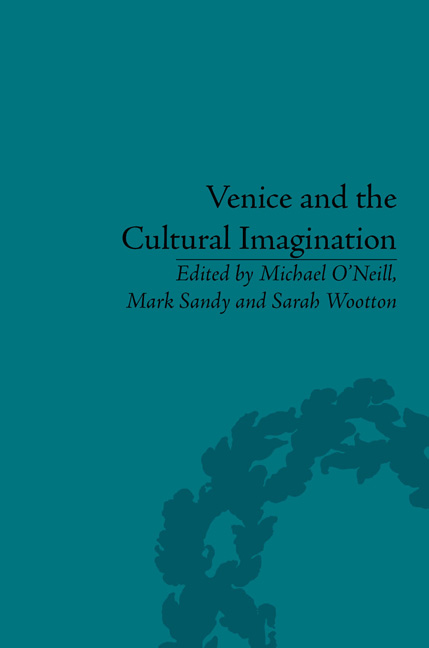Book contents
- Frontmatter
- CONTENTS
- Acknowledgements
- List of Figures
- Notes on Contributors
- Introduction
- 1 A ‘More Beloved Existence’: From Shakespeare's ‘Venice’ to Byron's Venice
- 2 Reimagining Venice and Visions of Decay in Wordsworth, the Shelleys and Thomas Mann
- 3 J. M. W. Turner and the ‘Floating City’
- 4 Venice and Opera: Tradition, Propaganda and Transformation
- 5 Venice, Dickens, Robert Browning and the Victorian Imagination
- 6 ‘The Lamp of Memory’: Ruskin and Venice
- 7 Edith Wharton's ‘Venetian Backgrounds’
- 8 Henry James's Venice and the Visual Arts
- 9 The Myth of Venice in the Decline of Eliot and Pound
- 10 Representations of Venice in Daphne du Maurier's Don't Look Now and Nicolas Roeg's Screen Adaptation
- Notes
- Select Bibliography
- Index
4 - Venice and Opera: Tradition, Propaganda and Transformation
- Frontmatter
- CONTENTS
- Acknowledgements
- List of Figures
- Notes on Contributors
- Introduction
- 1 A ‘More Beloved Existence’: From Shakespeare's ‘Venice’ to Byron's Venice
- 2 Reimagining Venice and Visions of Decay in Wordsworth, the Shelleys and Thomas Mann
- 3 J. M. W. Turner and the ‘Floating City’
- 4 Venice and Opera: Tradition, Propaganda and Transformation
- 5 Venice, Dickens, Robert Browning and the Victorian Imagination
- 6 ‘The Lamp of Memory’: Ruskin and Venice
- 7 Edith Wharton's ‘Venetian Backgrounds’
- 8 Henry James's Venice and the Visual Arts
- 9 The Myth of Venice in the Decline of Eliot and Pound
- 10 Representations of Venice in Daphne du Maurier's Don't Look Now and Nicolas Roeg's Screen Adaptation
- Notes
- Select Bibliography
- Index
Summary
To both the cogniscenti of opera, and even to those less enthusiastic about musical theatre, Venice stands as an immutable icon. From the city's vast wealth, geographical position and overflowing patronage of the arts sprang an impressively rich tradition of theatres where operatic productions of up to five hours thrived in competition with the church music of San Marco. Indeed, as the seventeenth century proceeded, church music at Venice's grand basilica and the ospedali (famous in Vivaldi's time in the first part of the eighteenth century) began to fall away as the attraction for theatre grew with even greater vigour. (As the demand for castrati massively decreased after about 1740, the musical opulence of Venetian church choirs declined markedly, a waning which Napoleon's ban of the castrato in 1800 made irrevocable except for the few singers who remained in the choir of the Cappella Sistina in Rome.) One of the most popular of Venetian performing spaces was the Teatro San Giovanni Grisostomo which opened in 1678 operated by the Grimani brothers. San Giovanni boasted the most extravagant productions in Venice and attracted noble patronage measured by the regular annual booking of boxes in the theatre and the impressive list of singers who were drawn to the theatre, among them Carlo Broschi, better know as the castrato Farinelli.
- Type
- Chapter
- Information
- Venice and the Cultural Imagination'This Strange Dream upon the Water', pp. 59 - 78Publisher: Pickering & ChattoFirst published in: 2014



